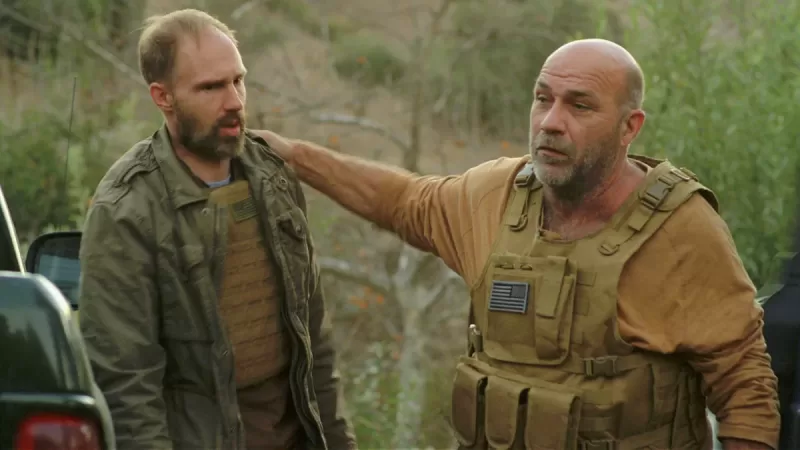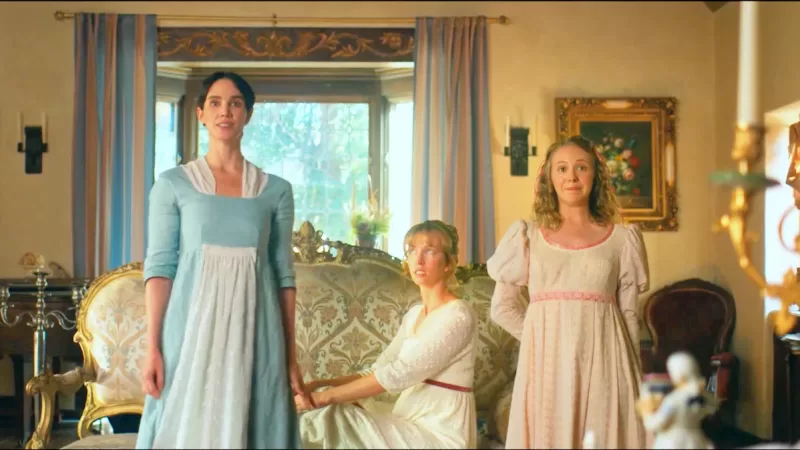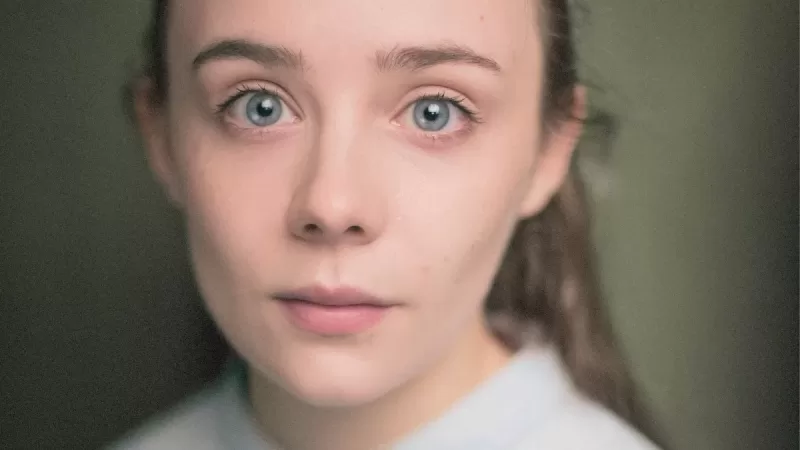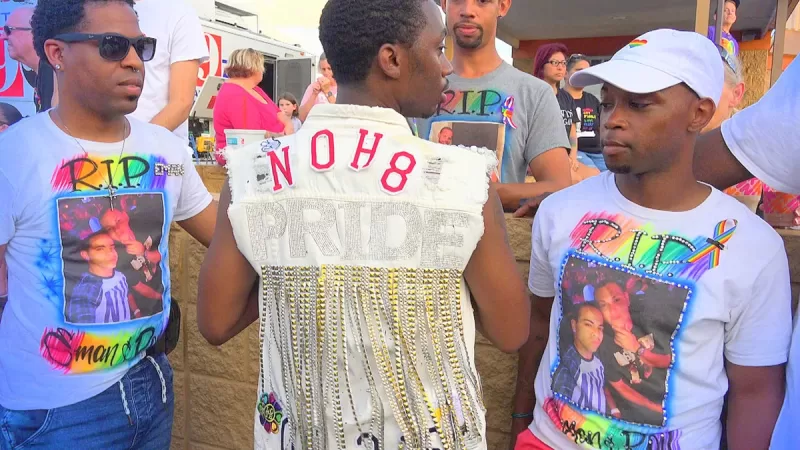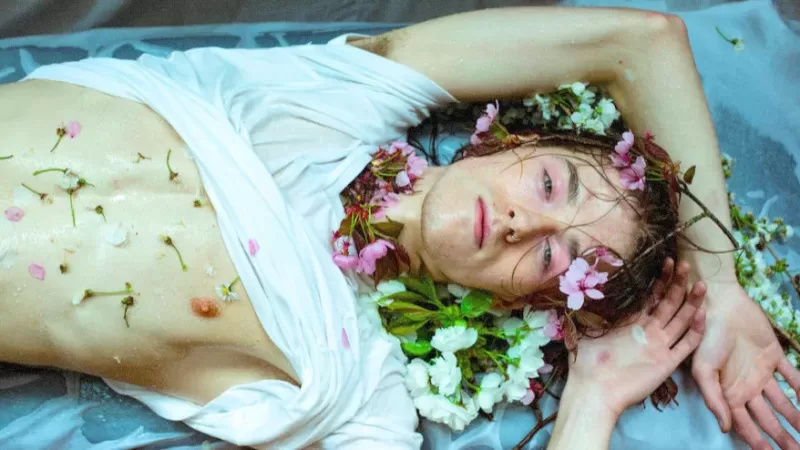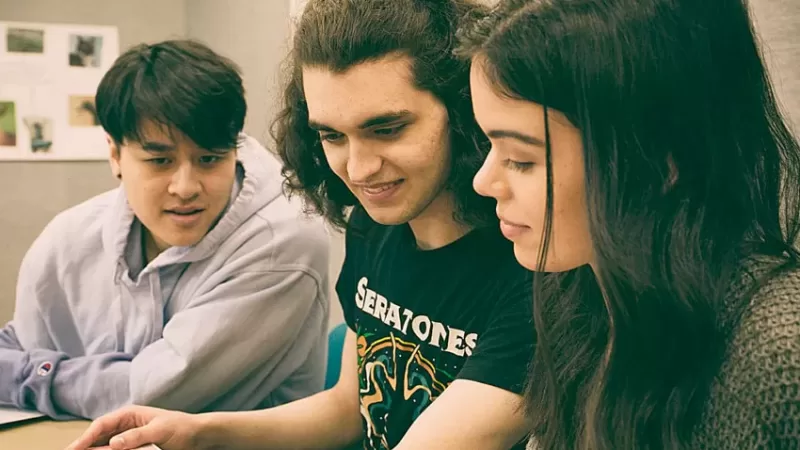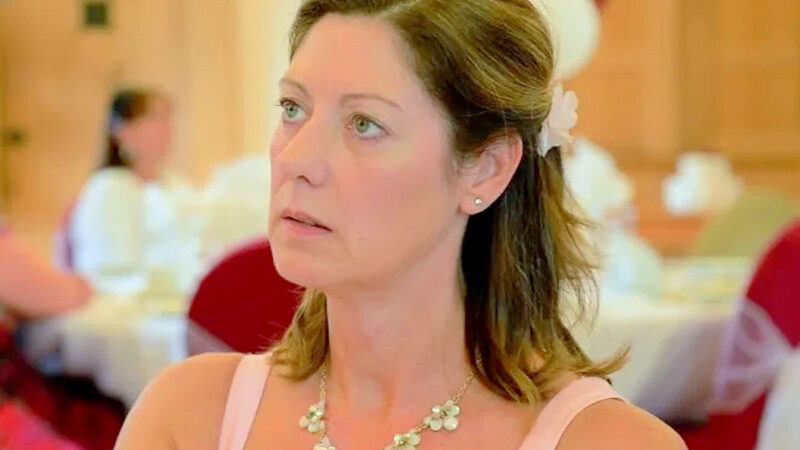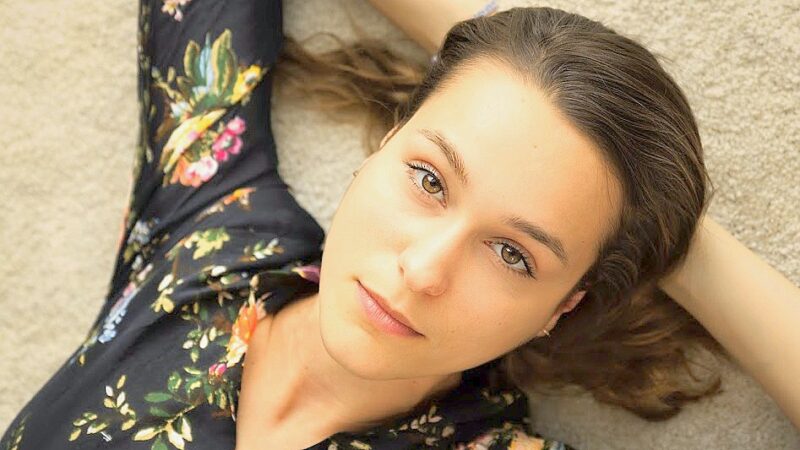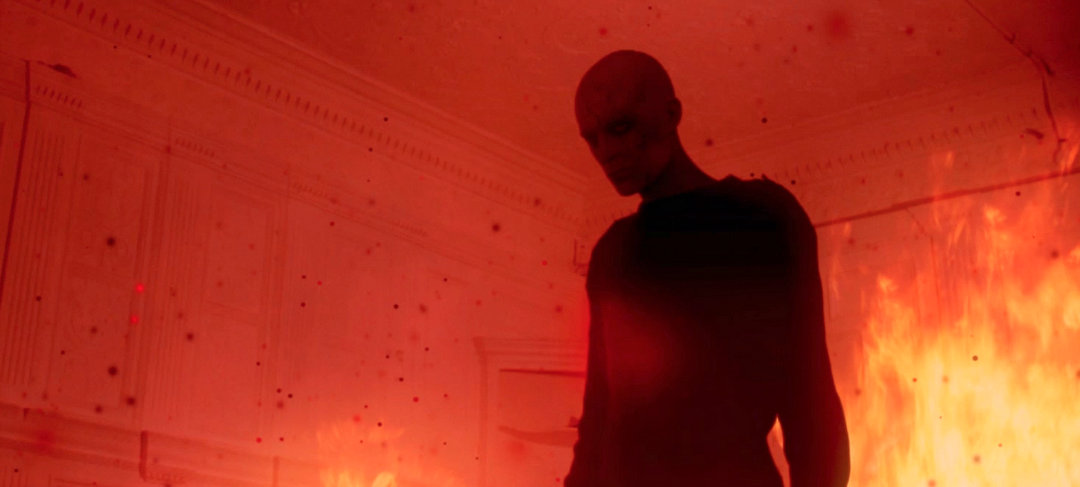
A screenshot from AntiHuman a film by Luke Gietzen & Mark Robins
Date: 30 Nov. 2017
Case Study: The Making of Antihuman
Filmmakers: Mark Robins & Luke Gietzen
Mark Robins and Luke Gietzen are two friends who grew up during the Cold War era. They are a filmmaking duo who run Monkey Puzzle Cinema. These two filmmakers walk us through their collaboration, discussion issues, progress, production and the marketing of their film, as we journey with them in the making of, AntiHuman.
indieactivity: What is your film about?
Mark: The film is titled “AntiHuman”, it’s primarily a science-fiction piece, telling the story of a young woman returning to a mysterious place from her past, searching for answers and finding cosmic terrors. Our idea was to do a genre piece with stranger and wider, and even angry, concerns and from an unusual perspective.
Luke: AntiHuman, or Post|Human: An Event under its original title, arose as have all of the projects I’ve worked on from conversations and development with my friend and co-creator Mark Robins. It presents our established concerns about time, memory, dreams and an attempt to understand the past. Although the film does not feature details of any specific time period it is notionally set in the Cold War period of the 80s in which Mark and I grew up with the background threat of a nuclear war.
This seemed less of a current concern when we filmed back in 2013. The film follows the journey of the lead character, Maggie, back to the facility in which she spent her childhood, which her three friends seem to think is ill advised not least because of her poor health. Once the group arrive, they encounter a figure from Maggie’s past whose motives, and very existence, seem questionable.
The relationships in the group are tested as the facility begins to reactivate in response to their presence. Maggie is forced to make a choice that affects not just the lives of her friends but the future of humanity.
indieactivity: Tell us about the festival run, marketing and sales ?
Mark: The film has just recently been launched across the USA and Canada, with wide video-on-demand distribution the first part of its staggered, multi-platform release.
Luke: Mark has worked tirelessly to publicise the film via our Twitter account. Wild Eye Releasing are marketing and distributing the film in the North American territories. Despite previous festival success we have not submitted Antihuman to any festivals. The film is the acting debut of Anya Korzun who has already gone on to win Best Actress at the 2017 Unrestricted View Film Festival for her second feature.
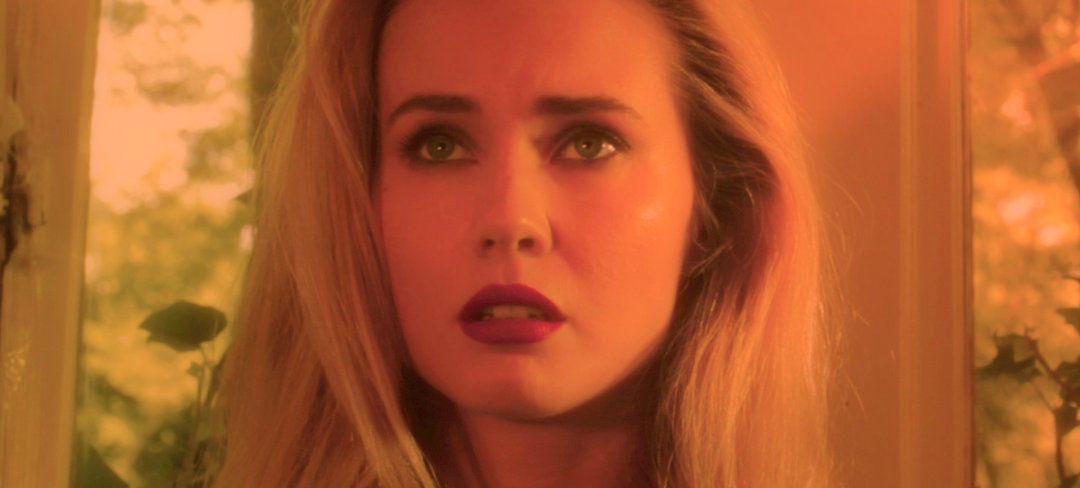
Anya Korzun as in Maggie AntiHuman
indieactivity: ‘Dramatic Feature’
– Director: Mark Robins & Luke Gietzen
– Producers: Florencia Diaz, Noel Gibb, Richard Jagdhar, Audrey Puddy, Luke Gietzen & Mark Robins
– Budget: Low.
– Financing: Various sources.
– Production: Principal photography completed within a month with extensive post-production thereafter
– Shooting Format: Digital HD 16:9, matted
– Screening Format: Digital/Physical (2.20:1)
– World Premiere: North American VOD Release October 2017
– Website: Monkey Puzzle Cinema
indieactivity: Do you take courses to improve your craft?
Mark: A young woman returns to the secluded, abandoned psychological research facility where her deceased mother once worked.
Luke: A unique and dark science-fiction film event, ANTIHUMAN tells the story of one woman’s return to the secluded and now-abandoned governmental research facility and mental asylum where her deceased mother once worked. Accompanied by three friends, she discovers that the ghosts of the past find their way to the present when the hospital’s legacy of experimentation and madness tears away all known bounds of time, memory and space. All the while, the very real threat of nuclear apocalypse grows ever stronger in the cities over the horizon.
indieactivity: Development & Financing?
Mark: Monkeypuzzle Cinema has been around for a little while now and after we completed our first feature, Maps And Stars And Music, which was a painterly, odyssean ghost story of sorts, and when it premiered as London’s Portobello International Film Festival, we won the Best Newcomer prize in 2010. The film had been shot, if I recall correctly, a little while previously on miniDV and by the time of the premiere, technology had overtaken us and wide, mainstream distribution of natively SD material wasn’t really commercially viable, so we decided to plunge into writing our next feature.
Three screenplays were the result of this and we picked this one as the most expeditious and the most likely to get made. The trick at the time was just to push ahead with each stage of pre-production in the hope that momentum might take over, as these things, from the perspective of the starting line, seem so monolithic and impossible and the idea of actually making and releasing a film seems like such a fantasy, that the work ethic of head-down-and-keep-going was the best thing, I thought, for the work to almost will itself into existence.
Anyway, we self-funded through various means including some crowd-sourcing, we started to look at actors and talking to crew and even spending money, by which time, that’s it, things are on the move and it is impossible to stop it. That was the whole idea of the project from the start; get it moving to a point that it might start moving itself and when that point is reached, steer as best you can. We always knew that the one thing that we really had no choice but to come out of it was that we would have a film at the end that could gain a legitimate release in one form or another.
We had always written genre work, horror and SF in particular, it had always been what we loved, so it was never a conscious decision that we would work in that style, it just seems to be what we do, and we do so in the belief that there is a lot of room for variance and range and differing approaches within that genre and we rely on thinking that other people feel the same way too and might respond.

Anya Korzun, Danielle Arden, Katie Keight & Kathryn Goldsmith as Maggie, Peggy, Avery & Catarina in AntiHuman
Luke: The first formal typed-up ideas for the story and structure came from Mark in March 2012. The final screenplay is dated July 2013. It took that year and a part for the two-page outline to become a 120 page script, with at least two name changes along the way. Reading the outline, which was titled ‘Slasher’ in a never-going-to-make-it-close-to-the-actual-title-just-attempting-to-capture-the-flavour, the core through-line of the story was there although it ended up with almost no remnants of its initial stalk-and-slash-in-a-secluded-and-spooky-location tone. It contains some other concerns and themes that were pruned for this project that we’ll likely include in future projects.
Before and during (plus some limited after) that period, Mark and I discussed what we wanted to see, how we wanted the story to develop, and what we could layer in to make the film something that would interest us enough to work on. We both work ‘normal’ jobs and met regularly albeit briefly as we’ve tended to do since we started making films together as Monkeypuzzle. Emails and Google drives of course featured largely when we weren’t physically in the same place.
So after Mark’s initial idea, a lot of the shape and back-story came from our walks and talks. Mark may be kinder here, I think my main function in screenplay development is to express pedantic irritation at certain logical aspects and attempt to sow in some links and resonances by suggesting some prehistory for the story. If that’s done right it will likely not end up in the final script although it will influence its tone and structure. Mark then has the discipline to flesh out the outline and characters and type up a screenplay, plus he writes far better dialogue than I can.
There’s an almost complete draft screenplay at September 2012 (with another name) which became complete in February 2013 before the first appearance of the film’s original ‘Post|Human’ title in June 2013.
The film was financed through our crowd funding campaign and funds we raised ourselves. The campaign closed in July 2013 and featured ‘mood board’ concept images and a video promotion from Mark explaining what we hoped to achieve with the film along with links to our previous projects.
We knew that with Antihuman we were going to require, and therefore pay, a crew along with the niceties of actually seeking permission to film in exterior locations and source, and again therefore pay for, a suitable interior for the main location. We had on previous projects used public spaces and shot everything ourselves. We were also working with a larger cast than we had assembled before, whom we also paid. The project was produced by Mark, Florencia Diaz and me.
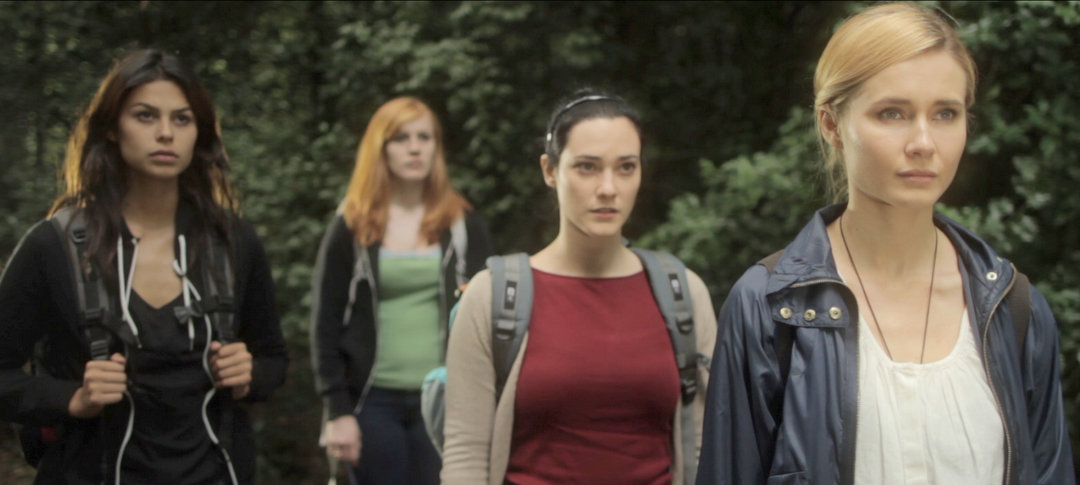
Anya Korzun, Danielle Arden, Katie Keight & Kathryn Goldsmith as Maggie, Peggy, Avery & Catarina in AntiHuman
indieactivity: Production?
Mark: Planning is an incredibly difficult and complex thing, but we were lucky in that we have an amazing producer in Florenica Diaz, and that my co-director Luke Gietzen is excellent at the minutiae of scheduling etc.; the film has two major environments, a forest and an abandoned asylum, and we allotted the beginning of the shoot to the former, which is on the edge of London, and spent around a third of our time there, with the majority of the rest devoted to this real-life institution that, in perhaps the biggest strokes of good fortune we enjoyed, we found right in the middle of London via a good friend who knew someone who knew someone there.
I shudder to think what would have happened had he not have helped us get this perfect place that looks like it exists out in the middle of nowhere. We did a little additional shooting and also wrapped up FX elements featuring a couple of the actors some at two more small London studios and it was nice to see it looking quite wild on-screen when it was all filmed in the capital.
We were lucky with the cast and I think the performances are really strong and authentic and sincere; I think we did well in trusting them; I think it also helps actors when you, as a director, work with editing in mind so much, because it lets them know they will be looked after onscreen, that we know how to emphasize their strengths and that the notion of the collision of two images provides as much, if not more, meaning as the images themselves, means that the actor’s know that we know how to place them well as part of the whole. And they were good with their work ethic and realising that there was a lot invested by us and we had a lot riding on it.
In many ways, it was quite a difficult shoot (during which the film was known as Post Human), with mainly the stresses of being an active producer wearing on me the most, but we shot well and expediently and were able to give it high production values. We had a very defined schedule, with everybody’s availability very limited, and we even managed to finish up just a little ahead of schedule and I started cutting the day after we wrapped and it is in the cutting where I am most sure of myself. I was pleased to see how good the footage looked, particularly at our forest location, and while there were some small disappointments in the examination of your accrued footage, now the film has to be finished from that which you have and it’s no use wishing for that which you don’t.
After an initial cut of around 140 minutes, it was tightened it up to 115. Then the very long process of shot-by-shot digital grading began. It was a very complicated and fussed-over process in this case; the aesthetic point-of-view of the film was a largely classical one. It was shot with the 2.2:1 AR of some large format processes in mind, (and masked for that ratio in editing), and in post, a lot of time was given to careful colour correction and to giving a diffused look (to reflect the story’s nominal, alternate reality, time-frame setting) which was a deliberate attempt to escape a digital look and provide it with an authentically filmy feel without going too far into a faux style. The FX house Artist Tree worked their magic through what I know was an extremely gruelling schedule and request list for them. During this, time was taken to make a range of strong promotional art and get a really nice trailer cut to get the online presence started with something vivid and representative of the quality ideals you had envisioned for the final picture.
With the cut decided, ADR was recorded where needed and an entire frame-by-frame clean up of the dialogue was performed, (perhaps one of the more frustrating parts of post-production), then foley was created from scratch.
We were very lucky with the music composers, with Chris Cavoretto of synth-rock band Werewolves In Siberia providing us with two excellent pieces of music, (which, to my everlasting regret were so intricately and skilfully intertwined with the scenes they underscored, that when those scenes had to be cut during editing, that music sadly want with it, too, to my great sorrow), and two composers working separately, Elias Mazzucco and Vaughan Bloomfield, created the score and provided just so much brilliant work; the film is lucky to have them.
The mixing and balance of the FME tracks was another testing and difficult process, but after that was reached, with just a few audio and FX elements missing, I decided that straight away we would seek channels to get it seen, bypassing the festival route, confident that we had a good, professional picture and it was pleasure to find Wild Eye Releasing; they were enthusiastic and supportive and smart and so pleasant to deal with as soon as we crossed paths, I thought we were very lucky indeed.
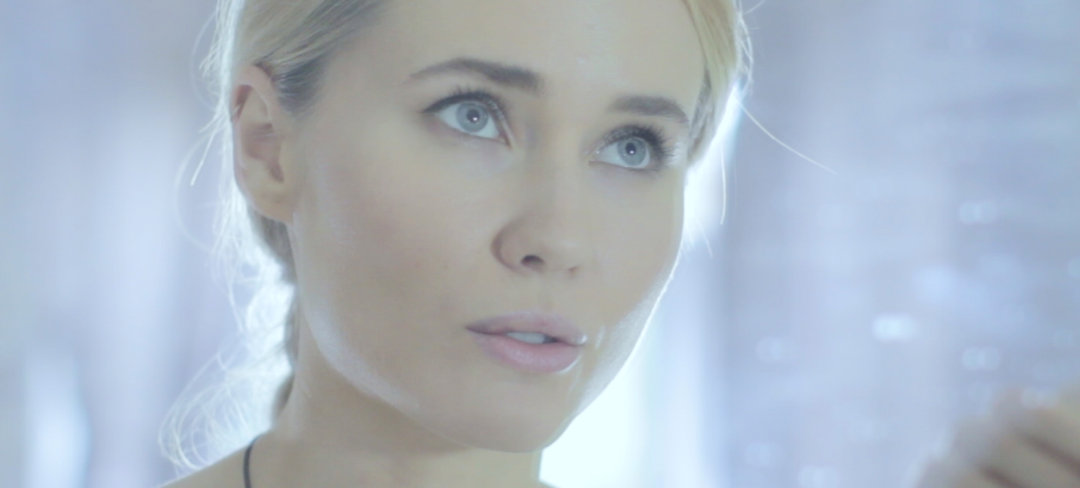
Anya Korzun as in Maggie Luke Gietzen & Mark Robins AntiHuman
Luke: In May 2013 we produced a detailed scene breakdown and schedule listing required cast and crew, location, approximate timings, props and special requirements. This was a simple Excel document we later used to generate daily call sheets and shot lists, and to track what we’d shot. For me this was more important than the script as it boiled down the structure to its essentials, plus I’m just a spreadsheet sort of person. We had fixed start and end times for exterior day shots and assumed (correctly as it turned out) that we would likely need to operate within a 9am-6pm range for our main interior location. It was tight to fit a dialogue-heavy 120 page script into 14 days, with two scheduled for a studio environment (one green-screen, one to fake a tent interior at night), with the additional concern of watching the payroll increase from the same schedule. We scheduled additional time for the weightier scenes, and wherever possible the aim was to group the scenes by required characters and costume to reduce changes and keeping anyone, ourselves included, waiting.
The first four days of the shoot would cover the woodland exterior day locations. Days five to 12 were for the main interior location, with some establishing shots and other interstitial suturing listed for a catch as catch can basis. The two studio days made the total up to 14, with some additional material that Mark and I would shoot as our own second unit after the main production. We knew we would also need some ADR time after the main shoot.
In early June 2013 we held interviews for a production manager. For these interviews we sent our candidates a mini-job description and spent around an hour each with five questions focussing on previous practical experience of negotiating rates for locations, useful contacts and the like. Although we didn’t click with everyone we saw, they were all professional with impressive experience and eager to help.
Maria, our successful candidate, was able to suggest a cinematographer, Seth, and assistant (both production and camera) Joe whose show reel easily convinced us. We found a sound recordist and a colleague from work volunteered a production assistant who proved to be invaluable. Some friends and work colleagues also volunteered some days.
Later in June 2013 we held cast interviews, scheduled for 45 minutes apiece to cover a solo reading of some prepared script pages, sent in advance with a three-page document outlining the tone of the film and character biographies for each of the cast. We filmed these, helped by another work colleague who joined us as an assistant camera operator on some shoot days, although I don’t think we referred back to the footage. We spent as much time as possible listening to how people liked to work and what interest they had in genre films and their first responses to the material. We scheduled a read-through for mid July to give us some time to account for any difficulties.
In July 2013 we scouted locations, sought permits, and finalised the shooting script ahead of the full read-through with our cast, and agreed contracts and pay. We made early savings where possible such as asking the sound recordist to join us only for the interiors as we doubted from the scout that any location production audio would be useable, and rescheduling an exterior shot to the main location since it had an extensive and overgrown back garden that would easily match with and double for the woodland exterior for some shots.
In August 2013 we finalised the budget, and made final plans for our first shoot day on 7 August, ensuring call sheets were available.
The shoot itself went very smoothly. Our cast were line perfect and easily carried our extended takes to cover whole scenes in a master with a simultaneous close-up from our second camera. Apart from a couple of days where it was not possible, and some setups that did not require it, we always ran two cameras for each shot. We perhaps got too used to not having to account for sound recording in the exterior days, although our sound recordist ably handled simultaneous medium and close up shots for the interiors. Our crew were efficient and Seth always accurate as to the time he’d need to set up lighting once we’d walked through each scene.
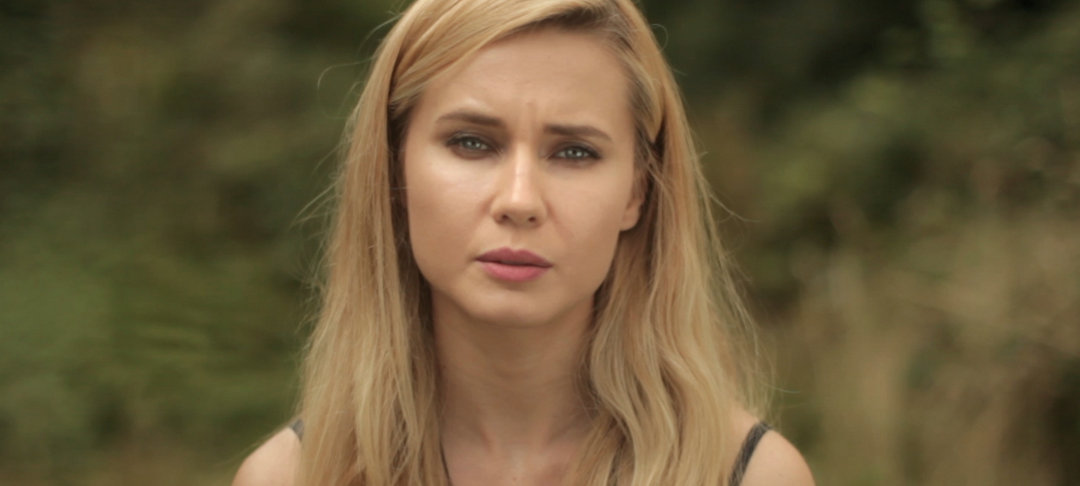
Anya Korzun as in Maggie Luke Gietzen & Mark Robins’ AntiHuman
indieactivity: Festival Preparation & Strategy?
Mark: As I mentioned, it was decided to forego the festival route, determined as we were to focus on the end goal of finding ways to get it seen and so we went looking for ways to do this. We were lucky, then, to team with Wild Eye. Since the cut they first saw and the release that has now happened, the film has been tightened to 112 minutes and undergone a title change. It was always the one goal of this whole endeavour from end with a nice release, so a lot of time from post-production to awaiting for that release, was used to create a good web presence, a good website and interesting and varied and good promotional art etc., so that when people come and have a look at your site or follow you on Twitter, the imagery that is available to them reflects your ethos and aesthetic well and it might even be something that they enjoy, whether it persuades them to see your movie or not.
Also, you can never forget that it was likely seeing materials like this in your youth which helped grow the desire in you to make a movie of your own so it is one of the nicer pleasures in all this that you get to make posters and one sheets and quads, much in the same spirit as you did when you were young but now with more polished and technologically advanced tools that just a pen and paper, except this time it’s not for a fantasy film that doesn’t exist or for someone else’s real-life picture, but rather for your own, actually-made project. That’s one of the nicer parts of this. Much of all it is incredibly stressful, but that bit is nice.
indieactivity: The Release?
Mark: Wild Eye have the release staggered, with VOD going out wide now across all major platforms in the United States and Canada, with a physical release likely before Christmas and subscription-on-demand in 2018, and are looking at international, too.
Luke: Antihuman is available via Video On Demand and Digital HD now and coming soon to physical media and subscription on demand thanks to Wild Eye Releasing.
indieactivity: Advice from the filmmakers?
Mark: There’s so much that is learnt through making a feature, but more than anything the key for physical production is preparation. And then more preparation and when you think you have prepared enough, prepare some more.
Try and do things like get to know your prospective locations and their geography when you may still have time for a rewrite so your script can live in the spaces you shoot rather than vice versa; do as much thinking as you can for the thematic and artistic points you want to make with the whole endeavour because the practicalities of shooting, (as, especially if you are a producer, more time and attention will be spent on the solving of very practical problems than you might expect), do not lend themselves to creating an atmosphere best for creating and identifying such artistic ideals.
But in terms of turning the desire to make a film into an actuality, the key thing is focus over a long time. Most filmmakers at our level will be engaged with a film, to the exclusion of all else, for four, five years, from inception to release and throughout those years, literally every single day there will be so many difficulties and obstructions both expected and unpredictable, and, perhaps worst of all, a sort of cacophony of indifference from most of the rest of the world and the one thing that you have to keep doing is simply keep going. Persist in your intentions, be patient and remember the long game, be diplomatic but also stubborn, but most of all, keep focused, always keep attention to every little detail and just do not stop.
Sometimes the days will have you feeling like no progress is being made, but you just have to attend the job of that day, even if it’s one concerned with seeming minutiae, (be it the negotiation for location insurance or difficulty of maintaining the density of digital diffusion across a picture cut during grading), finish it well and then attend to the next thing. And eventually these tasks, which will ultimately number in the thousands and for which you or a small group of you are solely responsible in both the creative and the practical worlds, will amass into something complete and whole and, as far as anything can be ever be, finished.
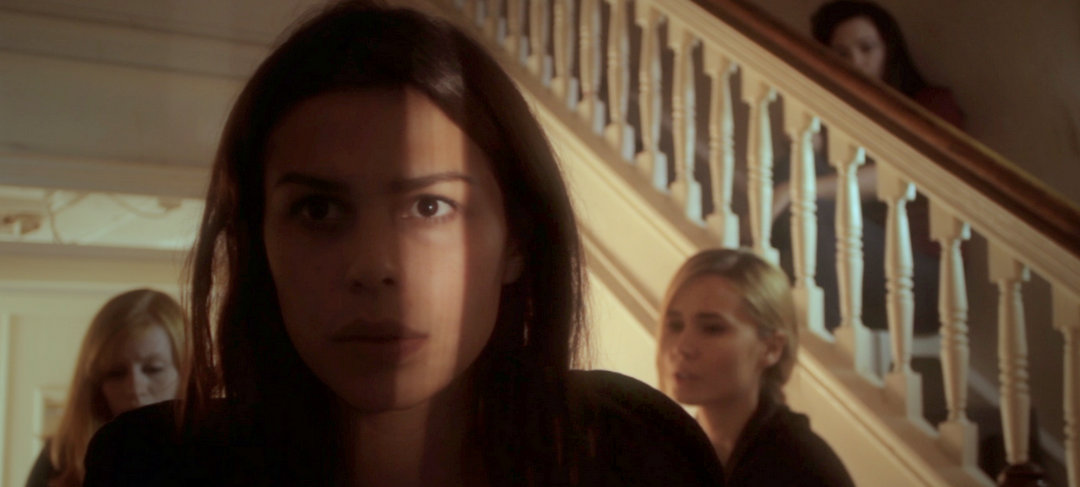
A scene from AntiHuman
Luke: As with our other projects, Antihuman is of our own devising; writing, directing, producing and editing. I’ve known Mark for nearly 30 years and collaborated with him for almost 20. I can’t see me doing this without him, and much of the way we work together comes from a desire to make something the other one will like, since there’s increasingly not so much of that around. I like to think that we end up in the same place although we can take very different routes to get there.
If you don’t have a Mark I’d advise you find one. No, seriously. I guess if it can’t be a Mark then what I’d suggest is that you have at least one trusted pair of eyes to look over what you’re planning to let you know if it sounds wrong, or too optimistic. And if possible to bounce ideas off, spitball or however you describe it. I wouldn’t suggest you will, or should, always agree with them. Nor they with you.
I also wouldn’t suggest you necessarily ‘write small’ if your budget is limited. Certainly whenever we attempt to do that we get carried away. Often my fault, can’t help it. Constraints often result in better choices and better work, even if they are not self-imposed ones. And there will always be constraints from logistics, permissions, money and the lack of a time machine. That said, we shot broadly in chronological order and broadly in a single location once the story reaches a certain point, and selected our locations with variety and flexibility in mind alongside the practicalities of accessibility.
Remember that everything you schedule will probably take twice as long to prepare and actually shoot. Although our main location was easy to get to, gave us options for multiple interior and exterior scenes and soon felt like home, our time there each day was distinctly bounded. Towards the end of the shoot, some factors meant that we needed to radically reconsider an important sequence. One of the scenes we shot to achieve that was among the most productive and enjoyable hours I’ve spent, choreographing our operators and cast and leaving them to work in a chaotic dance for which the main direction was essentially for the characters’ unravelling to endanger the fabric of the film itself. I think we drove our cinematographer and his main assistant a little crazy, and pity even further our sound recordist for having to keep up with the dance; the result even in the first edit was everything I’d hoped for. So I wouldn’t necessarily recommend storyboards either, although a list of shots and a firm plan of what you need is of course essential, before you can start exploring and developing and complicating it further.
It’s a collaborative process. You already know that. Things will not go to plan, and things will go wrong, and you will deal with that. Remember to take care of yourself, your cast and your crew. And enjoy it. It’s not something everyone will get to do.
Day Labor by R. Ellis Frazier, Action Thriller Gets May Release
Freestyle Digital Media Acquires Action Thriller “Day Labor” For May Release
Jane Austen’s Period Drama Wins Audience Awards at Cleveland International Film Festival
Julia Aks and Steve Pinder’s Whimsical Comedic Short Wins The Audience Choice Award
Thomasin Lawson, Joins Honor Swinton-Byrne and Greta Bellamacina on “All Five Eyes”
Alta Global Media on board to Executive Produce the US/UK Co-Production
Exclusive Interview with Aleesha Yates on Feature Documentary, “Surviving Pulse”
Aleesha Yates is a driving force behind making “Surviving Pulse: Life After a Mass Shooting” feature doc.
Jack Roper Joins Cast of Bruno Pischiutta’s Mega-Film Project, The Trilogy
British Actor Jack Roper joins Stephanie Tripp, Seven Grant, and Cristina Perez
The Exploding Boy by Monty Wolfe. The Micro-Budget Queer Coming Of Age Comedy
Monty Wolfe delivers an up-beat alternative to reboots, remakes, and sequels.

